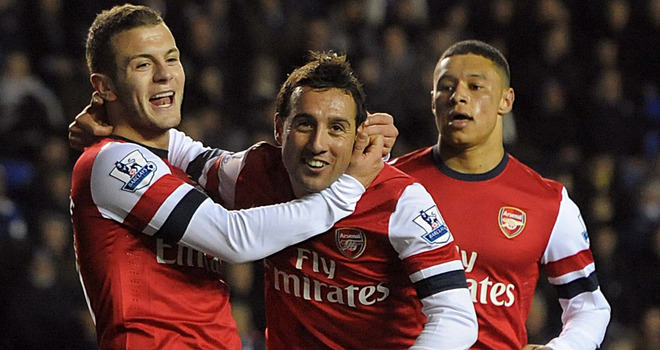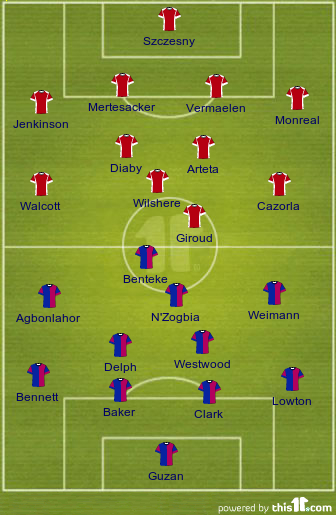In hindsight, a nervous and far from capacity Emirates Stadium saw a predictable result. While Arsenal have a habit of grinding out an important win after major setbacks, Aston Villa have made it a habit of conceding late goals to drop crucial points. In this aspect, Paul Lambert needs to take a hard look at himself and his team. Saturday’s match, however, wasn’t the brightest of points in the tactical CVs of the two managers. Naivety and anarchy seemed to be the order of the day.
Line-ups and formation
Carl Jenkinson replaced an injured Bacary Sagna as right back. Centre forward Olivier Giroud, central midfielder Abou Diaby and left back Nacho Monreal returned to Arsene Wenger’s starting line-up after the midweek humiliation in the Champions League. Jack Wilshere started in an advanced role behind Giroud, while Santi Cazorla drifted in from the left flank.
For Aston Villa, injured skipper Ron Vlaar was a huge miss in the centre of defence which forced Lambert into playing a makeshift central defensive pairing of Ciaran Clark and Nathan Baker. Gabriel Agbonlahor returned to the starting line-up after missing the narrow win over West Ham due to illness. Charles N’Zogbia played as the attacking midfielder behind the in-form Christian Benteke.
Match analysis
Villa’s counter-attacking strategy
Paul Lambert had set up his side to play on the counter-attack with his front four possessing the ideal characteristics to do so – a bullish target man accompanied by three pacey forwards. However, Villa’s strategy has always been risky and flawed. It involves little to no control of possession, relying heavily on directness and execution of quick attacks.
Except for a brief spell in the first half, the away side did little to keep possession and take the sting out of the game. It is true that Lambert’s team had numerous opportunities on the break and they scored with one of them, but they weren’t nearly as solid as a counter-attacking side ought to be on an away day. The score line is a reflection of Arsenal’s low confidence and inability to convert chances and not Villa’s away performance.
According to EPLIndex’s stats centre, Arsenal had 63.9% possession, completing nearly double the number of passes (535:277), and creating nearly triple the number of chances (22:8). The number of passes made in the final third is indicative of how Villa made little attempt to keep hold of the ball and release defensive pressure. While Arsenal managed 228 passes in the final third at an accuracy of 82%, Villa only managed 79 passes with a low accuracy of 63%.
Arsenal’s left flank – strength and weakness
The first half saw some repetitive patterns, especially down Arsenal’s left hand side. The January signing from Malaga, whose services were sorely missed against Bayern Munich as he was cup tied, offered an attacking outlet down the left that allowed Cazorla to drift inside. One of Monreal’s forward forays eventually resulted in the decisive play of the match when he sneaked in behind Villa and squared for Cazorla to slot in Arsenal’s late winner.
With Cazorla drifting in, Wilshere buzzing in an advanced central role, Diaby making occasional runs from deep and N’Zogbia doing little tracking back, Villa’s holding midfielders Fabian Delph and Ashley Westwood had too much to contend with. Thus, Arsenal found plenty of space to play the ball around them resulting in neat one-twos and chance creation.
The downside of Monreal’s attacking endeavors was that he was often caught out of position. Some sloppy passing and cheap giveaways in the first half by Arsenal’s midfielders left him stranded deep in his attacking half. Villa were intelligent in attacking the space he left behind, but weren’t clinical enough in the final third to exploit it.
Wenger acted upon this weakness in the second half when Wilshere and Cazorla swapped their primary positions to provide better cover for Monreal; the Englishman defensively better than the Spaniard.
Santi Cazorla vs. Charles N’Zogbia
The match, by virtue of being a very open affair, relied on individual quality to decide the game. Aston Villa had ample opportunity to exploit wide open spaces in Arsenal’s defence, for which they needed N’Zogbia (who had starred in their previous match) to be less wasteful and frustrating.
The French midfielder lost possession a massive 21 times in only 52 touches. He was dispossessed 8 times in the match and attempted only 29 passes at a poor accuracy of 76%. His failure to release a timely and accurate pass not only affected Villa’s overall attacks but also reduced Benteke’s involvement in the game.
On the other hand, Cazorla was Arsenal’s lynchpin. The Spaniard scored 2 goals, completed 66 of his 73 passes (90% accuracy), created the joint highest number of chances (4) and completed 4 of his 5 dribbles. The match winner was the second most involved player on the field (106 touches) behind Wilshere (113 touches).
Openness and substitutions
At times, this match was a free-for-all; a case study in anarchy and naivety. Arsenal were a goal up early on but judging by their play, you’d think they were trailing by three goals from the first leg. The home side had no intentions of even remotely closing up shop as they frequently exposed themselves on 3 versus 3 and 4 versus 4 counter-attacks. It took either manager a full ninety minutes to make the first defensive change of the game – Laurent Koscielny for Theo Walcott.
Lambert, however, simply refused to shore up his overrun midfield. Even when they drew level, Lambert made a like-for-like swap in defensive midfield (Karim El Ahmadi for Ashley Westwood) leaving the shape unchanged. When he took off N’Zogbia, he could’ve introduced Brett Holman or Yacouba Sylla to lend El Ahmadi and Delph a helping hand. But he chose to introduce young winger Simon Dawkins instead. It was no surprise then that Cazorla arrived untracked and unmarked to score the crucial winner.
Match conclusion
This was a game that characterized the fundamental flaws on display in the Premier League this season; the kind that have been truly exposed in Europe. For a neutral, it was a great game to watch because it was an open affair. But it was baffling to see how both managers simply allowed the game to continue in its path without a major change in game plan.
In an open game, superior quality usually settles the match – something that had been the trademark of the best of Ferguson’s United sides who relied on the ‘we’ll score more than you’ motto. Cazorla, alongside the likes of Wilshere and Monreal, provided the difference on this occasion.


